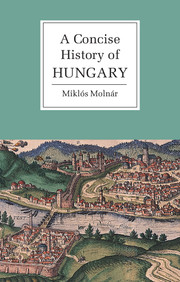Book contents
- Frontmatter
- Contents
- List of illustrations
- Acknowledgements
- Chronology
- 1 FROM THE BEGINNINGS UNTIL 1301
- 2 GRANDEUR AND DECLINE: FROM THE ANGEVIN KINGS TO THE BATTLE OF MOHÁCS, 1301–1526
- 3 A COUNTRY UNDER THREE CROWNS, 1526–1711
- 4 VIENNA AND HUNGARY: ABSOLUTISM, REFORMS, REVOLUTION, 1711–1848/9
- 5 RUPTURE, COMPROMISE AND THE DUAL MONARCHY, 1849–1919
- 6 BETWEEN THE WARS
- 7 UNDER SOVIET DOMINATION, 1945–1990
- 8 1990, A NEW DEPARTURE
- Bibliographical notes
- Index
1 - FROM THE BEGINNINGS UNTIL 1301
Published online by Cambridge University Press: 05 June 2014
- Frontmatter
- Contents
- List of illustrations
- Acknowledgements
- Chronology
- 1 FROM THE BEGINNINGS UNTIL 1301
- 2 GRANDEUR AND DECLINE: FROM THE ANGEVIN KINGS TO THE BATTLE OF MOHÁCS, 1301–1526
- 3 A COUNTRY UNDER THREE CROWNS, 1526–1711
- 4 VIENNA AND HUNGARY: ABSOLUTISM, REFORMS, REVOLUTION, 1711–1848/9
- 5 RUPTURE, COMPROMISE AND THE DUAL MONARCHY, 1849–1919
- 6 BETWEEN THE WARS
- 7 UNDER SOVIET DOMINATION, 1945–1990
- 8 1990, A NEW DEPARTURE
- Bibliographical notes
- Index
Summary
HUNGARY BEFORE THE HUNGARIANS: AN OVERVIEW OF THE TERRITORY
From the conquest of 895 up until the First World War Hungary's history unfolded in the Carpathian basin; then it was confined within a smaller territory, that of today's Hungary. This is a land situated at the same latitude as central France and the same longitude as its Slovak and Slav neighbours to the north and the south. Its western boundaries follow those of Austria, with present-day Ukraine to the north-east and Romania further to the east.
The oldest known inhabitants date back 350,000 years and traces of several successive prehistoric cultures have been found, from the Palaeolithic to the Bronze and Iron ages. Among the most important civilisations to have crossed the Danube were the Celts. They dominated Pannonia and a part of the plain which lies between the Danube and the Tisza in the third century BC. Meanwhile, further east, the Dacians, Thracians and Getians left behind their heritage in Transylvania as did the Illyrians in the south.
In the middle of the first century BC, a Dacian empire, led by Boirebistas, occupied vast expanses of the lower Danube region. This power was probably at the root of Rome's expansion towards Dacia and Pannonia. Initially under Augustus and Tiberius, Roman conquest brought civilisation and imperial forms of governance to the two provinces for nearly four centuries. The first stone bridge across the Danube was erected in 103 in what is today Turnu-Severin-Drobeta in Romania (Szörény in Hungary). Hungarian Pannonia/Transdanubia (Savazia – Pécs, Sophianum – Szombathely and Acquinicum at Budapest) are dotted with rich remains of Roman settlements.
- Type
- Chapter
- Information
- A Concise History of Hungary , pp. 1 - 40Publisher: Cambridge University PressPrint publication year: 2001

